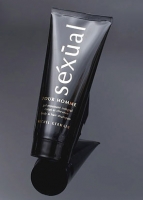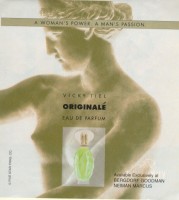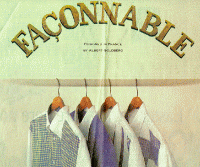Branding: IPA and exotism
L’API et les langues étrangères, ça sert a rendre les produits plus intéressants car exotiques. Un example particulièrement frappant est l’abus d’accents et autres signes diacritiques dans la pub sur le marché anglophone. On pourrait dire la même chose du pseudo-anglais dans la pub en France et ailleurs en Europe continentale.
My brain and mind, as I have mentioned before, feel these days like something that stayed too long in a hot frying pan. So I have quite a number of planned or partially written posts on language topics, and just can’t seem to be able to finish them. The question is: should I first (try to) complete the oldest ones and leave newer topics and comments on recent posts on other blogs for later (FIFO), or rather try to stay on top of the new debates and things that catch my eye, and add commentaries on stale topics whenever I get trough to them (LIFO)? Whichever it is, “garbage in, garbage out” remains correct, and in this spirit, I just plodding on looks like about the best I can do.
![IPA in branding: clothes brand [íxi:z] IPA in branding: clothes brand [íxi:z]](../../../../images/apixiz01.gif)
![IPA in branding: clothes brand [íxi:z] IPA in branding: clothes brand [íxi:z]](../../../../images/ixiz2.gif)
Last summer, several linguistics blogs were abuzz with examples of (pseudo-)IPA being featured in adverts.
Now yesterday, while googling for some German expressions I just might blog one day, I came across another example: [íxi:z], which appears to be a clothes brand (probably an American one). Their use of IPA is in some respects better than other examples I have seen. At least the characters they use are (more or less) all actually part of the phonetic alphabet.
Still, I am unclear about whether the acute accent on the í is supposed to (correctly) indicate high tone, or (incorrectly) stress; and, which is strange for something written out phonetically, how to pronounce the brand name. Because, frankly, I don’t trust them to have it gotten right (people who are pretentious enough to provide no version of their brand/company name spelled in a writing system appropriate for wherever they advertise their products don’t deserve much credit in my book). So the x might refer to the sound in the German word ich (an unvoiced velar fricative), or to what is better transcribed as [ks], which would make the brand name sound like “Pixies” without the initial p (and with a voiced final s).
I found this example on Harold Shiffman’s site for his class Language and Popular Culture (LING 057) at U Penn. The page in question deals with what he calls “foreign branding” in product naming.
The site is packed with interesting examples, but I hesitate to recommend its perusal without reservations because there are several points and features I find questionable or annoying. The most harmless is probably the fact that most images don’t load without tricks. (Thank you, Scrapbook extension for Firefox.) The page is also rather imprecise (not to say misleading) on the EU and French regulations about elements of product names that indicate the region or place of origin.
More seriously, Shiffman doesn’t make a distinction between exotism (though the use of foreign languages or bits that make product names look foreign, like diacritics) in ads that are directed at an American public and ads for a market in the products country of origin the particular national flavour of which is expressed through the branding. There is a difference between a product that is made to sound French (or German, or Japanese) for an English-speaking market, and a product the branding of which plays on its X-ness for the market in country X. An example of his vagueness is Lancôme, whose products of course do look French, as it is the case for many, if not most, beauty product lines. But the distinctive O-with-circumflex Ô relies first and foremost on particular shades of meaning for French speakers: the “upper-class” pronunciation of the letter o the circumflex accent indicates, the resonance with money-soaked places like Place Vendôme in Paris, the wordplay Ô — eau (as in eau de toilette). Lancôme admit to turning the circumflex accent into a prestige object in their home-grown “company saga”.
Another example where exotism is slightly off as an interpretative category are the ads for the Eurostar high-speed train that runs between London and Paris. Since I live in one of these two cities (and I have actually travelled on this train a couple of times), I have been exposed to a great number of their ad campaigns, which nearly all mix English and French, or cultural attributes or stereotypes of Englishness and Frenchness. But the slant is less about a taste of a far-away culture than about creating the desire to actually go there and have a look. In this respect it is closer to French ads for French vacation spots than for German cars.
Since the images on Shiffman’s site are all but inaccessible anyway, here some examples of the use of pseudo-French in the branding of fashion and beauty products. The recipe: take some vaguely French-sounding word and add accents and other diacritics, seriously misplacing them. For these three images, clicking on the thumbnail leads to a slightly larger version.
Note that the acute accent in séxūal is off to the right, and phonetically nonsensical anyway (just like the one in originalé), and that “ū” is not a French character at all (leaving aside that the correct French adjective is sexuel). “Michel Germain” is apparently an exclusively north-American brand. On their site, they couldn’t figure out how to do “ū” in HTML, so they used “ü”. A tribute to the arbitrariness of the accents.
As for façonnable, unlike what Harold Shiffman says, it is actually a French word, and means “capable of being shaped or moulded” (quite exactly what fashionable would mean if its meaning were compositionally derived from the verb fashion and the suffix -able). I agree with him, though, that its supposed meaning here is a frenchified version of fashionable (which translates into French as à la mode).
Related posts: Pseudo-phonetics, Minimalist Kitkat, Pas aussi atroce que ça !, Transcribing an unknown language, More on dealing with unknown languages, Transcribing another unknown language, IPA + 1!
Technorati (tags): advertising, IPA, language, langue, phonetics





If you are interested, I wrote a 56 page pdf on naming products and companies that is free to all here.
In the 1970s Renault sold a car in the US that was marketed as “Le Car,” telling no one that in French this means “the bus.”